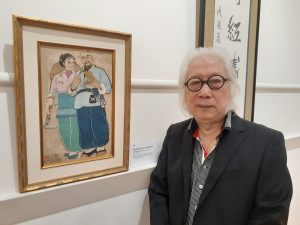Migrant artist’s passion endures through conflict and persecution
When the Cultural Revolution engulfed China in 1966, zealots among the Red Guard set fire to all of emerging artist Hong Fu’s works – except for one.
A painting of a farmer and his wife that Hong had painted when he was 16 and at art school was particularly loved by his grandmother and sat on her kitchen window.
“The Red Guard didn’t search my grandmother’s house so when they burned all my early work, that was the one they missed,” Hong said.
The painting is among works recently on display at the Victorian Artist’s Society in Melbourne as part of ’60 Years of Art Life – A Retrospective Exhibition of Hong Fu’.
 Hong was born in eastern China in 1946. His father ran a successful construction company employing 4000 people.
Hong was born in eastern China in 1946. His father ran a successful construction company employing 4000 people.
“In 1950, our family moved to Beijing because it was the cultural centre of China. We were wealthy and we had a beautiful life,” he said.
“I was interested in art from a young age. I started studying calligraphy from the age of five and I had natural talent as an artist.
“My dream was to be an artist, it consumed my whole body and soul and I have dedicated my life to it ever since,” Hong said.
He enrolled in the Institute of Arts and Design in Beijing in 1962 aged 16, where he studied a wide range of art in a traditional and rigorous over six years at the boarding institution.
But like millions of Chinese, Hong became a victim of the Cultural Revolution, instigated by Chairman Mao, which saw up to a million people killed and millions more persecuted and sent to re-education camps because they were allegedly ‘bourgeois elements’.
“My family was targeted because we were accused of being capitalists. We lost out wealth because of this and my art was destroyed by the Red Guards,” Hong said.
For the next ten years all Hong was able to paint were images of Chairman Mao.
“Between 1966 and 1976 I was painting images of Mao. Some of them were 10 metres high and were murals in universities and factories,” he said.
“Mao became effectively a cult in China, we were taught he was a God,” Hong said.
Hong worked for another ten years in the art industry. Then he became an art director with China Central Television producing stage and TV dramas. And he was the director of the Artist’s Gallery in Beijing, which was the first non-government gallery in China after the Cultural Revolution.
“The gallery was a great success. We held more than 300 exhibitions for young and emerging artists from all over China,” Hong said.
But the Tiananmen Square massacre in 1989 – which saw student-led democracy demonstrations brutally crushed by the military with hundreds of thousands killed – upended Hong’s life once again.
“The massacre in Tiananmen Square was the end of everything. My gallery was destroyed by the military. There were 300,000 troops sent to Beijing and they killed thousands of people – it was terrible,” he said.
“It made me realise I had to go. I could not stay in China.”
Hong migrated to Australia in 1990, settling in Fremantle.
“Almost all I knew about Australia was that it ‘rode on the sheep’s back’ (a theme that is feature in one of the paintings in the exhibition).
“But I also knew it was a big country with a small population and I thought that was good and that there would be more freedom. I also wanted to live somewhere where there was democracy,” he said.
Hong says coming to Australia re-energised his art career.
“I’m very happy I came to Australia. It’s been 33 years and I am lucky to have been successful. I have worked hard and had a strong desire to produce art inspired by the beautiful countryside, the people and the sense of freedom,” he said.
 Hong has sold more than 3000 pieces of art and has won several awards and been a finalist in the Archibald Prize for portraiture.
Hong has sold more than 3000 pieces of art and has won several awards and been a finalist in the Archibald Prize for portraiture.
He has also sold pieces or art to raise money for charities including Melbourne’s Royal Children’s Hospital.
“Australia has given me freedom, a new life and career and I have wanted to give back something,” Hong said.
After four years in Fremantle, Hong moved to Melbourne initially brought to the city to attend a Christie’s art auction that featured his works.
“Melbourne is a cultural centre with many famous galleries. So, it was an obvious thing to move here,” he said.
“Now, some of these galleries have been handling my work for 30 years”.
Among Hong’s portraits are Cathy Freeman, his wife Echo Cai, Professor Mabel Lee and a recent one of independent teal politician Monique Ryan.
“I enjoy painting portraits because I love trying to evoke the strengths and qualities e finds in humanity,” he said.
The Retrospective Exhibition features several picture books he drew for Chinese publications after the Cultural Revolution, as well portraits and still life pieces.
One of the centrepieces is a large scroll-like drawing that is a record of the cultural and political history of China created over 18 months through the COVID lockdowns
Now 77, Hong says he has no plans to retire.
“Creating art is my life. I go to me studio every day and I will keeping doing so until the paint brush drops out of my hand,” he said.












